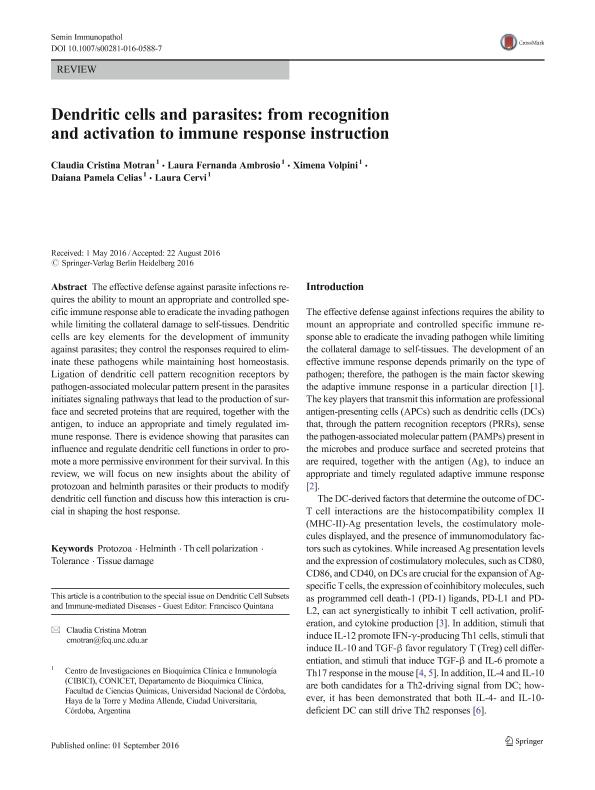Mostrar el registro sencillo del ítem
dc.contributor.author
Motran, Claudia Cristina

dc.contributor.author
Ambrosio, Laura Fernanda

dc.contributor.author
Volpini, Ximena

dc.contributor.author
Celias, Daiana Pamela

dc.contributor.author
Cervi, Laura Alejandra

dc.date.available
2018-12-03T17:41:37Z
dc.date.issued
2017-02
dc.identifier.citation
Motran, Claudia Cristina; Ambrosio, Laura Fernanda; Volpini, Ximena; Celias, Daiana Pamela; Cervi, Laura Alejandra; Dendritic cells and parasites: from recognition and activation to immune response instruction; Springer; Seminars in Immunopathology; 39; 2; 2-2017; 199-213
dc.identifier.issn
1863-2297
dc.identifier.uri
http://hdl.handle.net/11336/65615
dc.description.abstract
The effective defense against parasite infections requires the ability to mount an appropriate and controlled specific immune response able to eradicate the invading pathogen while limiting the collateral damage to self-tissues. Dendritic cells are key elements for the development of immunity against parasites; they control the responses required to eliminate these pathogens while maintaining host homeostasis. Ligation of dendritic cell pattern recognition receptors by pathogen-associated molecular pattern present in the parasites initiates signaling pathways that lead to the production of surface and secreted proteins that are required, together with the antigen, to induce an appropriate and timely regulated immune response. There is evidence showing that parasites can influence and regulate dendritic cell functions in order to promote a more permissive environment for their survival. In this review, we will focus on new insights about the ability of protozoan and helminth parasites or their products to modify dendritic cell function and discuss how this interaction is crucial in shaping the host response.
dc.format
application/pdf
dc.language.iso
eng
dc.publisher
Springer

dc.rights
info:eu-repo/semantics/openAccess
dc.rights.uri
https://creativecommons.org/licenses/by-nc-sa/2.5/ar/
dc.subject
Helminth
dc.subject
Protozoa
dc.subject
Th Cell Polarization
dc.subject
Tissue Damage
dc.subject
Tolerance
dc.subject.classification
Salud Ocupacional

dc.subject.classification
Ciencias de la Salud

dc.subject.classification
CIENCIAS MÉDICAS Y DE LA SALUD

dc.title
Dendritic cells and parasites: from recognition and activation to immune response instruction
dc.type
info:eu-repo/semantics/article
dc.type
info:ar-repo/semantics/artículo
dc.type
info:eu-repo/semantics/publishedVersion
dc.date.updated
2018-10-23T21:35:05Z
dc.journal.volume
39
dc.journal.number
2
dc.journal.pagination
199-213
dc.journal.pais
Alemania

dc.journal.ciudad
Berlin
dc.description.fil
Fil: Motran, Claudia Cristina. Consejo Nacional de Investigaciones Científicas y Técnicas. Centro Científico Tecnológico Córdoba. Centro de Investigaciones en Bioquímica Clínica e Inmunología; Argentina
dc.description.fil
Fil: Ambrosio, Laura Fernanda. Consejo Nacional de Investigaciones Científicas y Técnicas. Centro Científico Tecnológico Córdoba. Centro de Investigaciones en Bioquímica Clínica e Inmunología; Argentina
dc.description.fil
Fil: Volpini, Ximena. Consejo Nacional de Investigaciones Científicas y Técnicas. Centro Científico Tecnológico Córdoba. Centro de Investigaciones en Bioquímica Clínica e Inmunología; Argentina
dc.description.fil
Fil: Celias, Daiana Pamela. Consejo Nacional de Investigaciones Científicas y Técnicas. Centro Científico Tecnológico Córdoba. Centro de Investigaciones en Bioquímica Clínica e Inmunología; Argentina
dc.description.fil
Fil: Cervi, Laura Alejandra. Consejo Nacional de Investigaciones Científicas y Técnicas. Centro Científico Tecnológico Córdoba. Centro de Investigaciones en Bioquímica Clínica e Inmunología; Argentina
dc.journal.title
Seminars in Immunopathology

dc.relation.alternativeid
info:eu-repo/semantics/altIdentifier/doi/https://dx.doi.org/10.1007/s00281-016-0588-7
dc.relation.alternativeid
info:eu-repo/semantics/altIdentifier/url/https://link.springer.com/article/10.1007/s00281-016-0588-7
Archivos asociados
